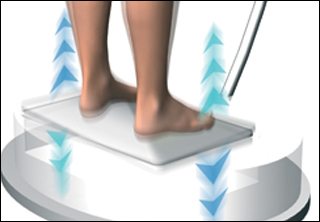 When skeptics hear the term “vibration” a red flag goes up, because that is a common term used in pseudoscientific jargon. Vibrations are often used to refer vaguely to energy or some physical or even spiritual property that cannot be detected, and is used in a hand-waving manner to explain extraordinary claims.
When skeptics hear the term “vibration” a red flag goes up, because that is a common term used in pseudoscientific jargon. Vibrations are often used to refer vaguely to energy or some physical or even spiritual property that cannot be detected, and is used in a hand-waving manner to explain extraordinary claims.
Vibrations, however, are also a real thing, referring to physical oscillations. Whole body vibration therapy (WBVT) refers to these legitimate physical vibrations. It is being offered as a treatment for balance, back pain, neurological disorders, and also simple fitness. Does it actually work, however, for the indications claimed?
What is WBVT?
WBVT is considered a passive exercise modality, in which something is being done to the person, rather than the person actively engaging in an activity, such as walking, weight lifting, or swimming. With WBVT users lay, sit, or stand on a platform that vibrates rapidly in one or more directions. The idea is that the rapid vibrations force the muscles of the body to contract in reaction, providing a form of exercise.
The plausibility of this treatment is therefore higher than many of the CAM therapies we typically discuss on SBM. In fact, I would not consider WBVT a CAM therapy. It is simply a relatively new treatment idea that is being explored.
Actually, the idea of using physical vibrations as therapy is probably much older, going back to the 19th century. However, research using modern WBVT machines is about 15 years old.
There are two basic categories of whole body vibration – physiotherapy simply uses vibrations to stimulate tissues, but not induce actual exercise. Whole body vibration training, however, uses the vibrations in combination with positions that induce muscle exercise, and should essentially be looked at as a form of physical exercise.
Various types of vibration can be used. Lineal refers to up and down movement. Pivotal refers to a “teeter-totter” movement. Either can also be high or low frequency.
As is often the case, there is the science of WBVT and its ethical incorporation into medical practice, and in this case also physical therapy and fitness, and then there are the claims that are made for WBVT by companies selling equipment. Not surprisingly, the commercial claims significantly outstrip the evidence.
For example, the Vibeplate has a long list of indications for WBVT including detox, back pain, increasing energy levels, increasing bone density, and neurological rehab. They also include this amusing explanation for why their product works so well:
We have gravity that pushes us from the top, it jams us into the earth and we have ground reaction force. Whole Body Vibration if properly mechanically designed, like the VibePlate, gives us vertical hits of the same kind of thing from the bottom up. Therefore, if we are caught in the middle, which the body is between gravity and the whole body vibration plate we also realize the benefits we are getting from the load of gravity, from the ability of the gravity to stimulate our bones, stimulate our muscles, stimulate our nerves, becomes very, very powerful. And if we can enhance that very quickly, very rhythmically, that is good.
I don’t know why they felt obligated to include a completely pseudoscientific explanation such as this, but it calls into question the reliability of everything on their site. Of course, gravity does not push people down from the top. Gravity is an attractive force – it is pulling down (at least in classic physics). It is also pulling equally on every atom in one’s body (ignoring insignificant tidal effects over the distance of a human body).
It seems that the marketing culture for medical devices and products requires this sort of magical explanation. Simply stating that WBVT is a form of exercise does not seem sufficient, there has to be a gimmick.
Does WBVT work?
Regardless of mechanism, the primary question is whether or not WBVT is an effective intervention. This question has to be asked for every individual use – WBVT by itself or combined with other forms of exercise and therapy, for each specific indication, and for various outcomes.
Let’s take the most basic question first – does WBVT have added benefit to regular exercise? A 2007 review found:
Twelve articles were included in the final analysis. In four of the five studies that used an adequate design with a control group performing the same exercises as the WBV group, no difference in performance improvement was found between groups, suggesting no or only minor additional effects of WBV as such.
Another 2007 review by a different group found:
Preliminarily, there is strong to moderate evidence that long-term whole-body vibration exercise can have positive effects on the leg muscular performance among untrained people and elderly women.
Looking through the specific studies, including some later than these reviews, that is generally what I find. The studies are mostly preliminary and tend to find that WBVT has some benefit for leg strength, specifically knee extension, but overall no significant difference than regular exercise. This makes sense, as the knee-extension muscles (quadriceps) are exactly those that would seem to be most exercised by standing on a vibrating platform.
Next up is bone density. This can be a serious problem in older individuals. It has already been demonstrated that weight-bearing exercise is beneficial to bone density. Perhaps WBVT is another option. A 2011 systematic review found:
Whole body vibration is beneficial for enhancing leg muscle strength among older adults. However, the review suggests that whole body vibration has no overall treatment effect on bone mineral density in older women. No randomized trial has examined the effects of whole body vibration on bone mineral density in older men.
Again, there seems to be a benefit for leg strength, but no specific benefit for bone density in women.
What about older subjects as a subgroup? A 2012 systematic review found:
Whole body vibration training may improve strength, power and balance in comparison with a control group, although these effects are not apparent when compared with a group that does conventional exercise.
This is another theme in the research results – WBVT works as a form of exercise for improving leg strength, but no better than other more conventional forms of exercise.
WBVT has also been looked at in patients with specific problems. In patients with lung disease, for example, either COPD or following lung transplantation, there seems to be benefit for walking endurance. This could simply be a leg strength effect, however.
WBVT is also being marketed at neurological populations, with the implication that it can positively affect neurological function beyond leg strength. In multiple sclerosis the evidence so far is unimpressive, as a 2015 review concludes:
Quality assessment revealed that the WBV training protocols were heterogeneous and the methodological quality of the studies was generally poor. We found borderline indication for improved 2-6 min walking endurance [ES=0.25 (95% CI=-0.06-0.0.55)] favoring WBV training whereas no benefits were indicated for short-distance (20m or less) walking speed or balance.
What about balance and walking overall? A 2015 systematic review found:
Although balance and mobility appeared to be responsive to WBV-plus-exercise, particularly in lower-functioning patients, compared with WBV-only, caution is required when interpreting the findings. Although there is some evidence for an overall effect of WBV on selected balance and mobility measures, its impact remains inconclusive.
Finally, a 2012 systematic review looking at functional treatment in neurological patients concluded:
There is insufficient evidence of the effect of WBV training on functional performance of neurodegenerative disease patients. Also, there is insufficient evidence regarding its beneficial effects on signs and symptoms of the disease, body balance, gait, muscle strength and quality of life compared to other active physical therapy or passive interventions in Parkinson’s disease or multiple sclerosis.
Conclusion: Putting it all together
The simplest way to make sense of the entire research literature on WBVT, in my opinion, is this – WBVT provides exercise to the legs, especially the thighs. This may improve strength, endurance, and walking. It does not appear to be superior to other forms of exercise, or to add much to a regular exercise program. It does not appear to have any specific benefits for bone density.
WBVT is a reasonable intervention to study, and it seems that more high quality studies are needed before we can definitely conclude its ultimate effects. However, existing evidence argues against any dramatic or specific benefit from WBVT.
The trap to avoid with this and other similar interventions is to fail to separate out specific from non-specific effects. WBVT is exercise, and provides the expected benefits of exercise, without providing any additional or novel benefits. For some, however, it has the allure of novelty, with the suggestion that it will provide some benefit beyond regular exercise. Certainly those marketing WBVT machines exploit this phenomenon.
Similarly, there is no evidence suggesting that yoga is anything but exercise, that meditation is anything but relaxation, or that Tai Chi is anything but exercise and balance training.
I think it is beneficial to our understanding, to guiding research, and to evaluating interventions to understand what they actually are, and to not get distracted by their superficial or gimmicky aspects.
WBVT may be useful as a form of exercise, but it does not appear to have any specific or unique benefits beyond that.

